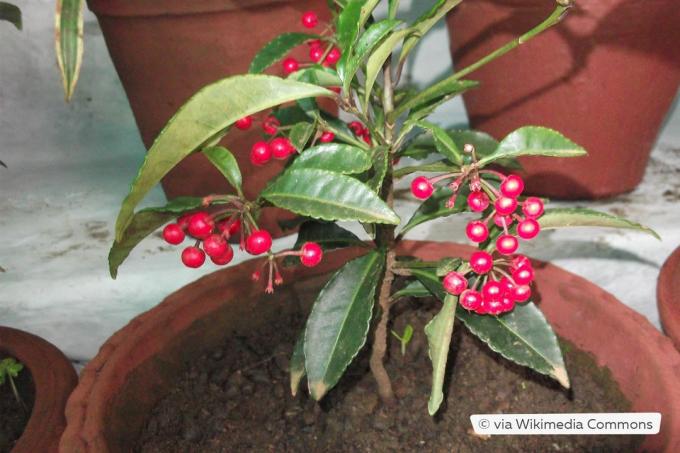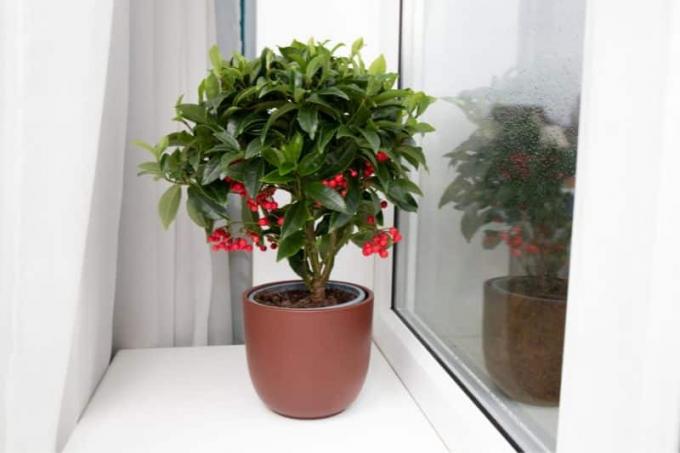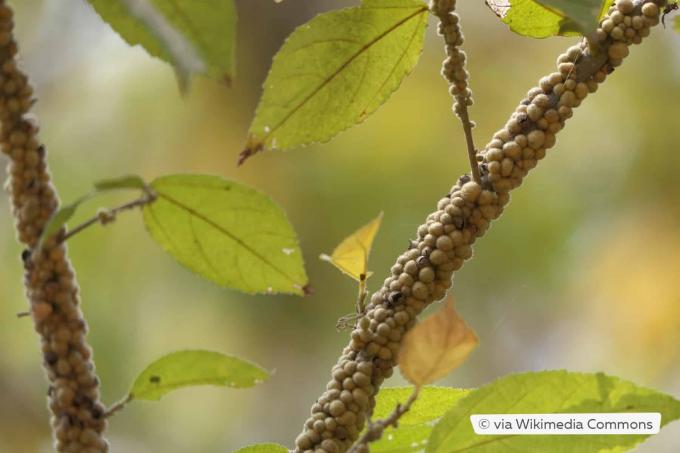
Profile and care information open +close -
- Flower color
- white
- Location
- Partial shade, sunny
- flowering time
- May June
- Growth habit
- bushy
- Height
- 100 - 150
- soil moisture
- moderately moist, fresh
- PH value
- sour
- Lime compatibility
- Lime intolerant
- humus
- rich in humus
- Poisonous
- Yes
- Plant families
- Primrose family, Primulaceae
- Plant species
- Houseplants, garden plants, ornamental plants
- Garden style
- ornamental garden
The notched pointed flower (Ardisia crenata) is a popular, evergreen house and garden plant. Proper care is essential for healthy growth and a long lifespan.
Table of contents
- Location
- Substrate
- Pour
- Fertilize
- Cut
- Thin cut
- Topiary
- Rejuvenation cut
- Repotting
- Correct procedure
- wintering
- Multiply
- seeds
- cuttings
- Pests and diseases
- Mealybugs and scale insects
- Leaf spot
- frequently asked Questions
Location
The notched pointed flower needs a location that requires certain requirements.

You should note the following requirements:
- bright, sunny to partially shaded
- Avoid direct midday sun and excessive heat
- Between spring and autumn the ambient temperature is around 20 degrees Celsius
- humidity consistently from 60 to 65 percent
- no cold drafts and strong temperature fluctuations
- In summer you can also use it on the balcony or terrace
Substrate
In order for these primrose plants to be able to cover their nutrient requirements and to ensure trouble-free nutrient and water absorption, the substrate should meet a few criteria.

The following requirements:
- loose and well permeable to water
- Commercially available substrate for green and potted plants with perlite or similar loosening materials
- rich in humus and nutrients
- normal garden soil with sand content
- Clay soil with sand content
- pay attention to an acidic pH value between 5.0 and 6.0
- low in lime
- Don’t forget drainage to avoid waterlogging
Pour
The coral berry or spice berry, as the notched pointed flower is also called, has a consistently high water requirement. It should never dry out completely. Overwatering causes waterlogging, which it also tolerates poorly. Therefore, various details should be taken into account when casting:
- Only water when less than 3 cm of the soil surface can be pressed in with your thumb
- Frequency: approximately once a week; possibly more frequently during the flowering period
- then soak the soil thoroughly
- Excess water must be able to drain through the drainage hole in the pot
- Significantly reduce watering frequency and amount of water in winter
- Keep the humidity high by spraying with low-lime water every day or setting up water bowls
- Use low-lime, stale water at room temperature
A notice: Direct spraying should only be carried out outside the flowering period. Otherwise there will be disruptions in later fruit formation.
Fertilize
Because the notched pointed flower has a moderately high nutrient requirement, the following should be taken into account when fertilizing:
- First fertilization from April for an ideal start to growth at the beginning of the season
- suitable types of fertilizer: liquid fertilizer for green and/or flowering plants; Long-term fertilizer as fertilizer sticks or pellets
- Alternative: organic fertilizer
- Frequency: Spring to late summer every 14 days; Long-term fertilizer once each in April and July
Cut
Cutting the notched pointed flower is occasionally necessary from a care perspective. This is the case, among other things, when dried shoots and leaves have formed that need to be separated because they absorb nutrients unnecessarily. But there may also be other reasons:
Thin cut
If the coral berry branches too much and therefore grows too densely, a light thinning cut between spring and summer is recommended. This involves cutting off older shoots at their base. This serves to improve air and light permeability, which results in a lower risk of pest infestations and diseases.
Topiary
Pointed flowers can be cut into decorative shapes, with the round cut being very popular. But protruding shoots from wild growth forms can also spoil the appearance and should be shortened for a more neat overall appearance. It should be noted that cutting off flower heads and flowers reduces fruit production. Therefore, the shape cut should not be too extensive. Topiary pruning is best done in autumn, but can also be done during the growing season.
Rejuvenation cut
For older specimens that have not experienced more vigorous pruning for a long time and have lost dense growth and have become lazy to bloom, rejuvenation pruning will encourage growth and increase vitality stimulated. Although shrubs should be cut in autumn, the secateurs should be used in early spring (March). All main shoots are shortened by 1/3. The inner shoots should remain longer than the side shoots.
Tip: The tapering cut technique can also be used on younger, smaller, notched pointed flowers. In this way, dense and faster growth can be stimulated.
Repotting
The best time to repot is spring so that the roots grow better and the notched pointed flowers recover more quickly from the stress of repotting. It is important to ensure that repotting is done before the start of the growing season and that new leaves have not yet formed. It would disrupt further growth and cause new shoots to die.
Newly purchased specimens are often planted in pots that are too small and in poor-quality soil, so they must be quickly replanted into fresh, high-quality substrate and a sufficiently large pot. Before the entire plant dies, repotting can also be done during the growing season.

Adult notched pointed flowers are usually only repotted into fresh substrate every two or three years. This also applies to cuttings you have grown yourself. However, there may be reasons that require repotting at an earlier date:
- Substrate collapsed
- complete root penetration of the pot
- Roots push outwards through the soil surface
- waterlogging
- Mold formation
A notice: If possible, the coral berry should not be repotted during the flowering period. This puts a lot of stress on them and can lead to premature wilting of flowers and reduced fruit production.
Correct procedure
To ensure that the spice berry receives optimal living conditions and fresh vitality through repotting, you should proceed as follows:
- Carefully pull the plant out of the planter (tapping on the pot walls loosens the soil and makes it easier to remove)
- Shake off old soil from roots
- Cut off dead root parts
- Slightly shorten the tips of the remaining roots
- Place in fresh substrate and water thoroughly
- Be sure to avoid direct sunlight for the next two to three weeks
wintering
The notched pointed flower is not hardy. If she has spent the summer outside, she will move into the warmer house when the temperatures approach the 12 degree mark.
The winter quarters and care during winter rest should meet these requirements:
- Temperatures between 10 and 14 degrees Celsius for hibernation
- Winter rest from October to March
- bright lighting conditions without direct sunlight
- If necessary, use a plant lamp with 1000 to 1500 lux
- suitable locations, for example stairwells or unheated winter gardens
- Only water when the soil surface is slightly dry
- do not fertilize
- From March onwards, slowly get used to higher temperatures and more light
- outdoors from mid-May at the earliest
Multiply
The notched pointed flower can be propagated in two different ways.
seeds
Seeds can be obtained from the ripe fruits. To do this, the shell must be removed. They usually reach maturity between November and January - recognizable by the bright red fruit color. Following are instructions:
- Sowing all year round; ideal February/March
- Substrate: nutrient-poor potting soil
- Press seeds lightly into soil and cover well with soil (dark germinator)
- Germination temperature: at least 22 degrees Celsius
- Germination time: around three weeks
- When sowing in seed boxes, prick out seedlings as soon as three leaves appear
- Transplant into a suitable, nutrient-rich substrate from a height of eight to ten centimeters
cuttings
The best time for propagation from cuttings is in May, when some new leaves have already formed due to the start of vegetation.
That's how it's done:
- Cut off the axillary cutting from the side shoot (no bark has yet formed from the main shoot)
- Cuttings should be 8 to 10 cm long
- If there is a flower or bud, remove it
- Insert the cutting with the interface 3 cm into nutrient-poor substrate
- Location: bright, sunny, warm at 24 to 26 degrees Celsius
- Spray daily with low-lime water
- Root formation after about six or eight weeks
- After several leaf formations, plant in a suitable, nutrient-rich substrate with sand content
- Keep substrate moderately moist
Pests and diseases
The Ardisia crenata is considered robust, but pest infestation or disease cannot be completely ruled out.
Mealybugs and scale insects
If there is a pest infestation, it is mainly mealybugs or scale insects that reside on the undersides of the leaves. Mealybugs form white, cotton ball-like webs on the leaves. Scale insects have a recognizable curved shield on the body and leave sticky honeydew on the leaves. An infestation can be expected between April and June.

Typical damage caused by mealybugs and scale insects:
- stunted flowers and leaves
- curled leaves
- Leaf discoloration
- increased leaf drop
Combat:
The most cost-effective control option is soft soapy water.
This is how it works:
- Dissolve 1 tablespoon (around 20 milliliters) in 1 liter of cold water
- If the infestation is severe, add 1/2 tablespoon of spirit
- Spray the plant, especially the undersides of the leaves, dripping wet with lye twice a day
- Stop using when parasites are no longer visible
Leaf spot
Leaf spot is caused by a fungal infection that occurs more often in ornamental and flowering plants. It manifests itself as brown or yellow, elongated leaf spots with a gray center.
combat
There is no known effective home remedy for leaf spot disease, which is why the only solution to the problem is a fungicide. However, it is best to take optimal care of the notched pointed flower so that the fungus is not attracted.
frequently asked Questions
This could be due to a location with strong temperature fluctuations or high temperatures. If this causes heat stress, the leaves turn yellow and wither.
Ardisia crenata is considered moderately poisonous to humans. Eating the leaves or berries can cause stomach and intestinal problems such as nausea and vomiting. The toxicity in animals has not yet been sufficiently researched, but it is suspected to be linked to some animal deaths. Therefore, the plant should always be placed out of the reach of children and animals.
Theoretically yes, but it is not recommended. It is not hardy and would have to be dug up again in the fall. This puts immense strain on the notched pointed flower and it can gather little to no energy for the upcoming winter rest.



